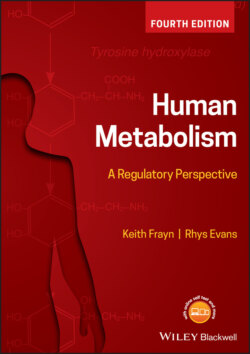Читать книгу Human Metabolism - Keith N. Frayn - Страница 48
Box 1.8 Deamination
Оглавлениеtransamination is a type of deamination but does not remove net N
presence of α-amino group prevents oxidative breakdown
therefore α-amino group must be removed before catabolism can proceed
the nitrogen can be incorporated into other compounds or excreted in the urine
different types of deamination but oxidative deamination is quantitatively the most important
| • oxidative | glutamate dehydrogenase |
| • non-oxidative | serine & threonine: hydroxyl in side chain |
| • hydrolytic | asparagine & glutamine: N in side chain |
glutamate is the only amino acid that undergoes oxidative deamination (glutamate dehydrogenase)
mostly occurs in liver and kidney
unusually can use either NAD+ or NADP+ as coenzymeNAD+ used mostly in oxidative deaminationNADP+ used mostly in reductive amination
direction of reaction depends on substrate availability (& hence metabolic state)
allosteric regulation (unusually for a readily reversible reaction):
The urea (ornithine) cycle occurs in the liver. Urea (CO·(NH2)2) contains two nitrogen atoms: one derives from ammonia (oxidative deamination of glutamate), the other from aspartate (transamination, also of glutamate, by AST) (Figure 1.21): the body excretes nitrogen with minimal carbon (and energy) loss. Because urea is very water-soluble, much nitrogen waste can be excreted for relatively little water loss, an important adaptation in terrestrial animals. Urea lacks toxicity at physiological concentrations; it is (neuro)toxic only in extremely high concentrations, for example those seen in untreated renal failure, but considerably less so than ammonia.
The urea cycle starts by forming carbamoyl phosphate from ammonia by the enzyme carbamoyl phosphate synthase (Figure 1.22). This is the regulated step of the urea cycle, but since ammonia is so toxic, the entire urea cycle must have a high capacity in order to deal with any sudden influx of ammonia-nitrogen if amino acid deamination is acutely increased. This may occur for example in starvation, when endogenous protein is broken down to yield amino acids for deamination and gluconeogenesis, or following consumption of large amounts of protein in the diet (protein cannot be stored as such and therefore the excess amino acids ingested are converted to more efficient energy storage forms [lipid], again following deamination). The carbamoyl phosphate transfers the nitrogen to ornithine, one of a series of amino acid intermediates found in the urea cycle but not used in protein synthesis. The second nitrogen in the urea molecule is introduced by aspartate from aspartate transaminase (see above). Of note, the urea cycle spans both cytosolic and mitochondrial compartments of the liver cell, as well as being partially present in other tissues (intestine, kidney) – possibly a mechanism to ensure that ornithine is not limiting and always available to accept carbamoyl phosphate (and hence ammonia, which cannot be allowed to accumulate).
Figure 1.22 Urea cycle. One nitrogen atom enters the cycle as an ammonium ion from glutamate dehydrogenase, whilst another enters from the amino acid aspartate, itself derived principally from glutamate via a transamination reaction. Hence the urea molecule contains two nitrogen atoms for only one carbon atom. The entire cycle is found only in liver, but sections of the cycle are present in other tissues, notably the intestine and kidney.
Besides urea formation, another route of nitrogen-ammonia excretion exists. In peripheral tissues (e.g. muscle) ammonia may be formed by the oxidative deamination of glutamate (by glutamate dehydrogenase, Box 1.8). This reaction, in combination with the aminotransferases, can be seen to capture amino nitrogen from a number of amino acids. However, blood ammonia concentrations are very low (it is highly toxic) and instead it is exported by being fixed in the amido (side chain) group of glutamine by the enzyme glutamine synthase: hence glutamine is ‘safely’ carrying two nitrogen atoms. In liver, the enzyme glutaminase removes the amido nitrogen of glutamine as ammonia for rapid incorporation into urea (an example of hydrolytic deamination: see Box 1.8). In kidney, glutaminase also removes the amido group of glutamine to form ammonia (and glutamate; glutamate dehydrogenase then deaminates this to form a second ammonia molecule), but here in the kidney the resulting ammonia is excreted directly into the urine where is acts as a urinary buffer (this means that the urine can be buffered without carbon loss). There is also a supply of ammonia from the small intestine (see Chapter 5, Section 5.8). These relationships are discussed further in Chapter 7 (Section 7.4).
